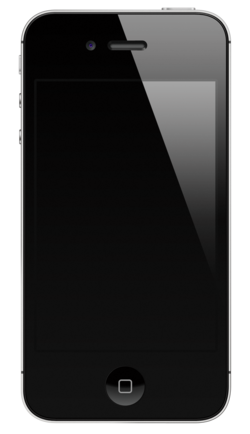The iPhone 4S is a touchscreen-based, slate-sized smartphone developed by Apple Inc. It is the fifth generation of the iPhone[5] and retains the exterior design of its predecessor, the iPhone 4, but is host to a range of improved hardware specifications and software updates.[6] The phone added a voice recognition system known as Siri, for which the S in the products name stands,[7] and a cloud storage service named iCloud. Some of the device's functions may be voice-controlled through Siri.
On October 4, 2011, in Cupertino, California, Apple announced the iPhone 4S. On October 7, 2011, it became available for preorder in seven initial countries (United States, Canada, Australia, United Kingdom, France, Germany and Japan) with the first delivery date set for October 14, 2011 and available on that same day for direct in-store sales in those countries. It was released in 22 more countries, including Ireland, Mexico, and Singapore on October 28.[8]
It is available for 100 cell service carriers in 70 countries, including eight carriers in the United States.[9][10] For US customers, unlocked (contract-free) sales started on November 11, 2011.[11][12] The Associated Press said that AT&T described early iPhone 4S demand as "extraordinary".[13] Reception to the iPhone 4S was generally favorable. Reviewers noted Siri, the new camera, and processing speeds as significant advantages over the prior model.[14][15][16] Four million units of the iPhone 4S were sold in the first three days of release.
On October 4, 2011, in Cupertino, California, Apple announced the iPhone 4S. On October 7, 2011, it became available for preorder in seven initial countries (United States, Canada, Australia, United Kingdom, France, Germany and Japan) with the first delivery date set for October 14, 2011 and available on that same day for direct in-store sales in those countries. It was released in 22 more countries, including Ireland, Mexico, and Singapore on October 28.[8]
It is available for 100 cell service carriers in 70 countries, including eight carriers in the United States.[9][10] For US customers, unlocked (contract-free) sales started on November 11, 2011.[11][12] The Associated Press said that AT&T described early iPhone 4S demand as "extraordinary".[13] Reception to the iPhone 4S was generally favorable. Reviewers noted Siri, the new camera, and processing speeds as significant advantages over the prior model.[14][15][16] Four million units of the iPhone 4S were sold in the first three days of release.









